Runze Cheng
Robust Brain Tumor Segmentation with Incomplete MRI Modalities Using Hölder Divergence and Mutual Information-Enhanced Knowledge Transfer
Jul 02, 2025Abstract:Multimodal MRI provides critical complementary information for accurate brain tumor segmentation. However, conventional methods struggle when certain modalities are missing due to issues such as image quality, protocol inconsistencies, patient allergies, or financial constraints. To address this, we propose a robust single-modality parallel processing framework that achieves high segmentation accuracy even with incomplete modalities. Leveraging Holder divergence and mutual information, our model maintains modality-specific features while dynamically adjusting network parameters based on the available inputs. By using these divergence- and information-based loss functions, the framework effectively quantifies discrepancies between predictions and ground-truth labels, resulting in consistently accurate segmentation. Extensive evaluations on the BraTS 2018 and BraTS 2020 datasets demonstrate superior performance over existing methods in handling missing modalities.
A semantic communication-based workload-adjustable transceiver for wireless AI-generated content (AIGC) delivery
Mar 24, 2025Abstract:With the significant advances in generative AI (GAI) and the proliferation of mobile devices, providing high-quality AI-generated content (AIGC) services via wireless networks is becoming the future direction. However, the primary challenges of AIGC service delivery in wireless networks lie in unstable channels, limited bandwidth resources, and unevenly distributed computational resources. In this paper, we employ semantic communication (SemCom) in diffusion-based GAI models to propose a Resource-aware wOrkload-adjUstable TransceivEr (ROUTE) for AIGC delivery in dynamic wireless networks. Specifically, to relieve the communication resource bottleneck, SemCom is utilized to prioritize semantic information of the generated content. Then, to improve computational resource utilization in both edge and local and reduce AIGC semantic distortion in transmission, modified diffusion-based models are applied to adjust the computing workload and semantic density in cooperative content generation. Simulations verify the superiority of our proposed ROUTE in terms of latency and content quality compared to conventional AIGC approaches.
Robust Divergence Learning for Missing-Modality Segmentation
Nov 13, 2024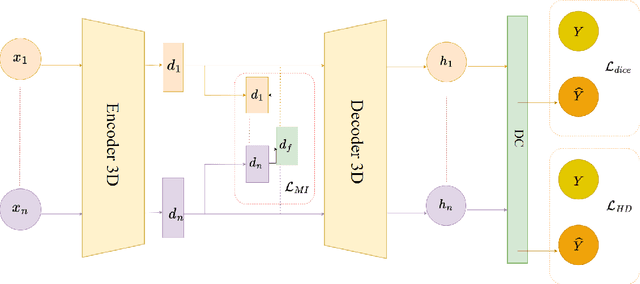
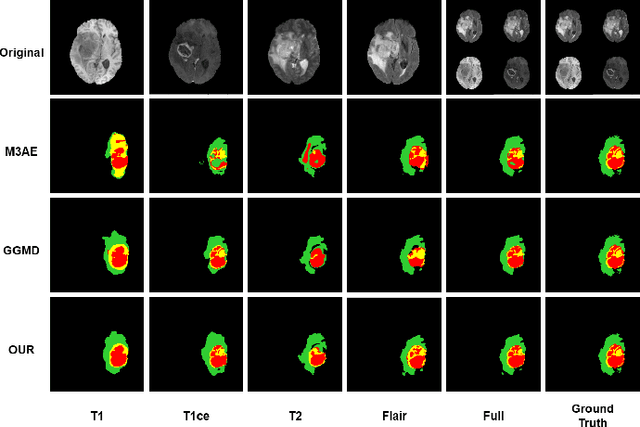
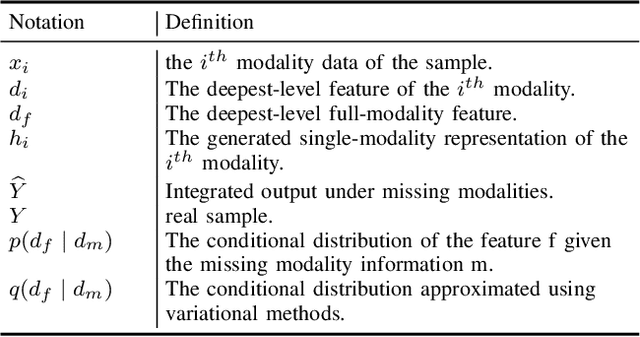
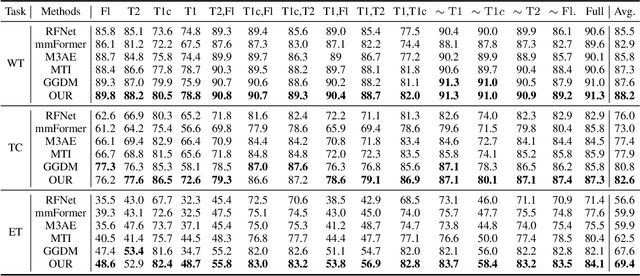
Abstract:Multimodal Magnetic Resonance Imaging (MRI) provides essential complementary information for analyzing brain tumor subregions. While methods using four common MRI modalities for automatic segmentation have shown success, they often face challenges with missing modalities due to image quality issues, inconsistent protocols, allergic reactions, or cost factors. Thus, developing a segmentation paradigm that handles missing modalities is clinically valuable. A novel single-modality parallel processing network framework based on H\"older divergence and mutual information is introduced. Each modality is independently input into a shared network backbone for parallel processing, preserving unique information. Additionally, a dynamic sharing framework is introduced that adjusts network parameters based on modality availability. A H\"older divergence and mutual information-based loss functions are used for evaluating discrepancies between predictions and labels. Extensive testing on the BraTS 2018 and BraTS 2020 datasets demonstrates that our method outperforms existing techniques in handling missing modalities and validates each component's effectiveness.
A Wireless AI-Generated Content (AIGC) Provisioning Framework Empowered by Semantic Communication
Oct 26, 2023



Abstract:Generative AI applications are recently catering to a vast user base by creating diverse and high-quality AI-generated content (AIGC). With the proliferation of mobile devices and rapid growth of mobile traffic, providing ubiquitous access to high-quality AIGC services via wireless communication networks is becoming the future direction for AIGC products. However, it is challenging to provide optimal AIGC services in wireless networks with unstable channels, limited bandwidth resources, and unevenly distributed computational resources. To tackle these challenges, we propose a semantic communication (SemCom)-empowered AIGC (SemAIGC) generation and transmission framework, where only semantic information of the content rather than all the binary bits should be extracted and transmitted by using SemCom. Specifically, SemAIGC integrates diffusion-based models within the semantic encoder and decoder for efficient content generation and flexible adjustment of the computing workload of both transmitter and receiver. Meanwhile, we devise a resource-aware workload trade-off (ROOT) scheme into the SemAIGC framework to intelligently decide transmitter/receiver workload, thus adjusting the utilization of computational resource according to service requirements. Simulations verify the superiority of our proposed SemAIGC framework in terms of latency and content quality compared to conventional approaches.
WiserVR: Semantic Communication Enabled Wireless Virtual Reality Delivery
Nov 02, 2022

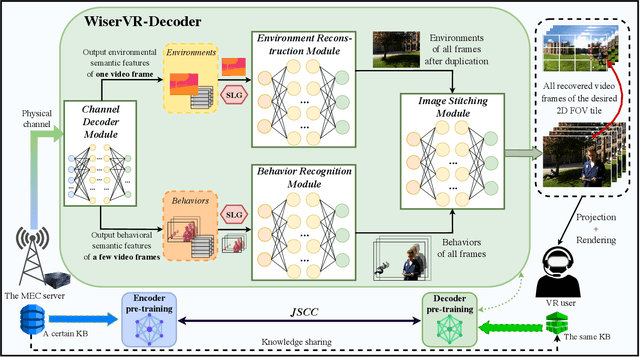

Abstract:Virtual reality (VR) over wireless is expected to be one of the killer applications in next-generation communication networks. Nevertheless, the huge data volume along with stringent requirements on latency and reliability under limited bandwidth resources makes untethered wireless VR delivery increasingly challenging. Such bottlenecks, therefore, motivate this work to seek the potential of using semantic communication, a new paradigm that promises to significantly ease the resource pressure, for efficient VR delivery. To this end, we propose a novel framework, namely WIreless SEmantic deliveRy for VR (WiserVR), for delivering consecutive 360{\deg} video frames to VR users. Specifically, deep learning-based multiple modules are well-devised for the transceiver in WiserVR to realize high-performance feature extraction and semantic recovery. Among them, we dedicatedly develop a concept of semantic location graph and leverage the joint-semantic-channel-coding method with knowledge sharing to not only substantially reduce communication latency, but also to guarantee adequate transmission reliability and resilience under various channel states. Moreover, implementation of WiserVR is presented, followed by corresponding initial simulations for performance evaluation compared with benchmarks. Finally, we discuss several open issues and offer feasible solutions to unlock the full potential of WiserVR.
 Add to Chrome
Add to Chrome Add to Firefox
Add to Firefox Add to Edge
Add to Edge